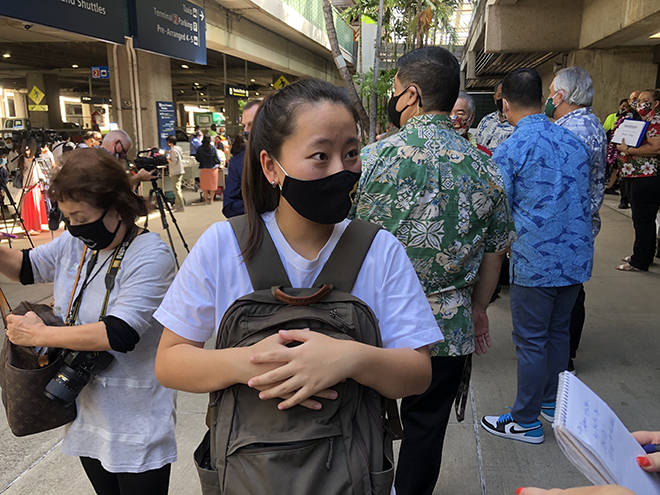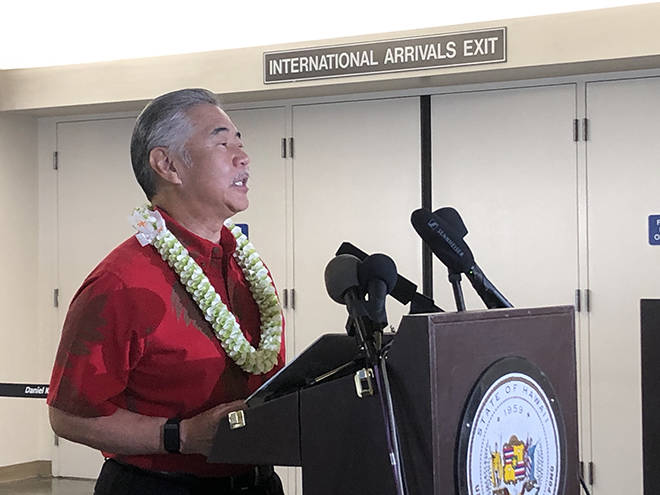Japanese travelers trickle into Hawaii at start of state’s pre-arrival testing program


CRAIG T. KOJIMA / CKOJIMA@STARADVERTISER.COM
Mei Shibata arrives at Daniel K. Inouye International Airport in Honolulu today, the first day that Japanese tourists could come to Hawaii and skip the mandatory 14-day quarantine if they tested negative for coronavirus prior to traveling.

CRAIG T. KOJIMA / CKOJIMA@STARADVERTISER.COM
Gov. David Ige speaks at Daniel K. Inouye International Airport in Honolulu today, the first day that Japanese tourists could come to Hawaii and skip the mandatory 14-day pandemic quarantine if they tested negative for coronavirus prior to traveling.



Visitors from the state’s top international market of Japan are back.
The first visitors from Japan to take part in the state’s pre-travel testing program started arriving today under an agreement that allows Japanese travelers to visit Hawaii under the same program as domestic passengers.
Since Oct. 15, domestic travelers have been able to bypass the state’s mandatory 14-day self-quarantine if they can provide proof of a negative Nucleic Acid Amplification Test coronavirus Opens in a new tab test taken from a trusted partner 72 hours prior to the last leg of their departure for Hawaii.
Today’s flight operated by All Nippon Airways brought 64 passengers from Japan to Hawaii. That’s almost as many visitors from Japan that came for the whole month of September, according to data from Hawaii Tourism Authority.
HTA reported that only 79 visitors arrived from Japan in September, the most recent data available, compared to 143,928 visitors in September 2019. HTA’s data shows that year-to-date through September, arrivals from Japan plummeted nearly 75% to just 294,647 visitors.
But even with the pre-testing program, the recovery of Japanese tourism is expected to be slow given that some Japanese nationals returning from trips abroad are required by the Japanese government to quarantine for 14-days upon their return home.
Don't miss out on what's happening!
Stay in touch with breaking news, as it happens, conveniently in your email inbox. It's FREE!
>> PHOTOS: Japanese visitors arrive in Hawaii Opens in a new tab
Also, the Japanese government still has the U.S. listed under a level three travel restriction, which advises Japanese citizens to “reconsider travel” to the U.S.
That wasn’t an issue for Mei Shibata, 19, who came off the plane proudly sporting a McKinley High School face mask.
Shibata, a Japanese national living in Tokyo, had graduated from McKinley High while her father was working in Hawaii. She returned to Hawaii to celebrate completing her college exam.
She said the pre-testing program, which awarded her a certificate to get out of Hawaii’s passenger quarantine, will allow her the freedom to enjoy her Hawaii visit.
“I can meet my friends, go shopping, go to the beach,” Shibata said.
She said it took her two days to get the test lined up in Japan and, at about $300, it was a little expensive. But to her it was well worth the cost.
Aiea resident Keiko Fujimoto also was glad for the chance to test out of quarantine so she can return to work promptly.
Fujimoto said she was on an extended visit to see family in Japan when Japan’s pre-testing program became available.
“My earlier flight was canceled. I was planning to come back Nov. 2, but it got pushed back to Nov. 6. I consider myself very lucky to be able to have taken the test,” Fujimoto said.
Fujimoto said the program worked well in Japan. However, she said she felt sorry for ANA because the plane wasn’t that full.
“We’ll get more people coming from Japan when they don’t have to quarantine when they go back,” Fujimoto said.
Eric Takahata, managing director for Hawaii Tourism Japan, Hawaii Tourism Authority’s Japan marketing contractor, said only a few thousand visitors from Japan are expected to come this year to Hawaii, which is projected to finish 2020 just shy of 300,000 arrivals.
In comparison, nearly 1.6 million visitors from Japan came to Hawaii in 2019 and generating nearly $2.2 billion in visitor spending.
Still, it’s a start.
Oahu will benefit the most from the restart of Japanese tourism. Takahata noted that there aren’t any flights currently scheduled to travel from Japan to Hawaii island, the state’s other international port of entry, through the end of the year.
Gov. David Ige was at Daniel K. Inouye International Airport today to greet the first visitors to come to Hawaii through the state’s first pre-arrivals testing program for international visitors.
“Today we welcome back visitors from Japan who are participating in the pre-arrivals testing program. This really does allow us to revive our economy and bring back trans-Pacific travelers in a safe way,” Ige said. “It’s important to understand that the pre-arrivals testing program is just one component of a layered health and safety protocol that we have put in place.”
The state Department of Health approved the COVID-19 Nucleic Acid Amplification Test authorized by Japan’s Ministry of Health, Labor, and Welfare on Oct. 14. But it took nearly two weeks more for officials to agree on a list of approved testing partners in Japan, which may soon be found at www.Hawaiicovid19.com. Opens in a new tab
Japanese visitors can find more information on www.Allhawaii.jp Opens in a new tab, the main Hawaii Tourism Japan website that includes COVID-19 information.
Ige said the agreement with Japan will kick off with 21 “trusted testing partners.”
All Nippon Airways, Japan Airlines and Hawaiian Airlines have announced the return of service and between them are offering eight scheduled flights for November.
Travelers coming from other international destinations still are excluded from participating in the state’s pre-arrivals testing program until they too get state-approved exemptions.
Ige’s original pre-arrivals order said that tests must be processed by laboratories that are licensed or certified by Clinical Laboratories Improvement Amendments of specimens for nucleic acid amplification testing approved or authorized by the U. S. Food and Drug Administration.
Ige said the state is working on adding travelers from Canada, South Korea, Taiwan New Zealand.
Daiserie Sausal said she wishes the state would consider adding the Philippines too.
Sausal and four other members of her family were at the airport to greet her sister-in-law Ruby Sausal, who had just arrived on a plane from the Philippines, which is not part of Hawaii’s pre-arrivals testing program.
“We wish people from the Philippines didn’t have to quarantine,” Daiserie Sausal said. “I would be better if they had something similar like they have for Japan.”




